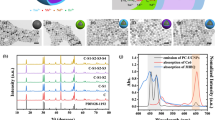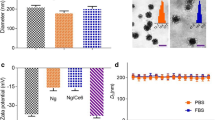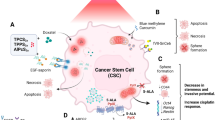Abstract
Glioma stem cells (GSCs) are major contributors to the recurrence and drug resistance of glioblastoma (GBM) and are therefore a key target for GBM treatment. However, due to the therapeutic resistance of GSCs, innovative and efficient clinical treatment tools to eliminate GSCs are urgently needed. Photodynamic therapy (PDT) is a new strategy for killing GSCs because of its high safety and sensitive targeting ability. However, the existing photosensitizers applied to kill GSCs generally lack long-wavelength excitation light with effective tissue penetration, which prevents their effective application in vivo. Hence, a novel near-infrared light (NIR)-activated photosensitive drug was developed from upconversion nanoparticles (UCNPs), Pluronic F127 (F127) and curcumin (Cur) to form UCNPs-F127@Cur. This hybrid nanodrug significantly promoted the apoptosis of GSCs, increased the production of intracellular reactive oxygen species, inhibited the expression of pluripotency-related genes in GSCs, and inhibited the growth of transplanted GSCs into tumors in vivo under 980 nm excitation light. However, UCNPs-F127@Cur did not exert the above anti-GSC effects without excitation by 980 nm light. Transcriptome sequencing analysis revealed that PDT with UCNPs-F127@Cur could cause cell cycle arrest and induce the differentiation of GSCs by suppressing the Wnt-β-catenin and Jak-Stat signaling pathways. In conclusion, we constructed a novel NIR-activated, targeted GSC-killing hybrid nanodrug and elucidated its molecular mechanism, thereby providing a new strategy for the treatment of GBM.
Graphical abstract
UCNPs-F127@Cur activated by NIR light with good tissue penetration were constructed and shown to effectively eliminate GSCs by inducing cell apoptosis, arresting cell cycle progression and the self-renewal of GSCs both in vivo and in vitro.









Similar content being viewed by others
Data availability
The data that support the findings of this study are available upon request from the corresponding author. The data are not publicly available due to privacy or ethical restrictions.
References
Radhakrishnan K, Mokri B, Parisi JE, Ofallon WM, Sunku J, Kurland LT (1995) The trends in incidence of primary brain-tumors in the population of Rochester, Minnesota. Ann Neurol 37(1):67–73. https://doi.org/10.1002/ana.410370113
Ostrom QT, Patil N, Cioffi G, Waite K, Kruchko C, Barnholtz-Sloan JS (2022) Corrigendum to: CBTRUS statistical report: primary brain and other central nervous system tumors diagnosed in the United States in 2013–2017. Neurooncology 24(7):1214–1214. https://doi.org/10.1093/neuonc/noaa269
Reya T, Morrison SJ, Clarke MF, Weissman IL (2001) Stem cells, cancer, and cancer stem cells. Nature 414:105–111. https://doi.org/10.1038/35102167
Bao SD, Wu QL, McLendon RE, Hao YL, Shi Q, Hjelmeland AB, Dewhirst MW, Bigner DD, Rich JN (2006) Glioma stem cells promote radioresistance by preferential activation of the DNA damage response. Nature 444:756–760. https://doi.org/10.1038/nature05236
Chen J, Li YJ, Yu TS, McKay RM, Burns DK, Kernie SG, Parada LF (2012) A restricted cell population propagates glioblastoma growth after chemotherapy. Nature 488:522–526. https://doi.org/10.1038/nature11287
Kolenda J, Jensen SS, Aaberg-Jessen C, Christensen K, Andersen C, Brunner N, Kristensen BW (2011) Effects of hypoxia on expression of a panel of stem cell and chemoresistance markers in glioblastoma-derived spheroids. J Neuro-Oncol 103(1):43–58. https://doi.org/10.1007/s11060-010-0357-8
Agostinis P, Berg K, Cengel KA, Foster TH, Girotti AW, Gollnick SO, Hahn SM, Hamblin MR, Juzeniene A, Kessel D, Korbelik M, Moan J, Mroz P, Nowis D, Piette J, Wilson BC, Golab J (2011) Photodynamic therapy of Cancer: an update. CA Cancer J Clin 61(4):250–281. https://doi.org/10.3322/caac.20114
Li XS, Lovell JF, Yoon J, Chen XY (2020) Clinical development and potential of photothermal and photodynamic therapies for cancer. Nat Rev Clin Oncol 17(11):657–674. https://doi.org/10.1038/s41571-020-0410-2
Hadjipanayis CG, Stummer W (2019) 5-ALA and FDA approval for glioma surgery. J Neuro-Oncol 141(3):479–486. https://doi.org/10.1007/s11060-019-03098-y
Schimanski A, Ebbert L, Sabel MC, Finocchiaro G, Lamszus K, Ewelt C, Etminan N, Fischer JC, Sorg RV (2016) Human glioblastoma stem-like cells accumulate protoporphyrin IX when subjected to exogenous 5-aminolaevulinic acid, rendering them sensitive to photodynamic treatment. J Photoch Photobio B 163:203–210. https://doi.org/10.1016/j.jphotobiol.2016.08.043
Fujishiro T, Nonoguchi N, Pavliukov M, Ohmura N, Kawabata S, Park Y, Kajimoto Y, Ishikawa T, Nakano I, Kuroiwa T (2018) 5-Aminolevulinic acid-mediated photodynamic therapy can target human glioma stem-like cells refractory to antineoplastic agents. Photodiagn Photodyn 24:58–68. https://doi.org/10.1016/j.pdpdt.2018.07.004
Omura N, Nonoguchi N, Fujishiro T, Park Y, Ikeda N, Kajimoto Y, Hosomi R, Yagi R, Hiramatsu R, Furuse M, Kawabata S, Fukunaga K, Kuroiwa T, Nakano I, Wanibuchi M (2023) Ablation efficacy of 5-aminolevulinic acid-mediated photodynamic therapy on human glioma stem cells. Photodiagn Photodyn. https://doi.org/10.1016/j.pdpdt.2022.103119
Ashrafizadeh M, Najafi M, Makvandi P, Zarrabi A, Farkhondeh T, Samarghandian S (2020) Versatile role of curcumin and its derivatives in lung cancer therapy. J Cell Physiol 235(12):9241–9268. https://doi.org/10.1002/jcp.29819
Liu FR, Gao S, Yang YX, Zhao XD, Fan YM, Ma WX, Yang DR, Yang AM, Yu Y (2018) Antitumor activity of curcumin by modulation of apoptosis and autophagy in human lung cancer A549 cells through inhibiting PI3K/Akt/mTOR pathway. Oncol Rep 39(3):1523–1531. https://doi.org/10.3892/or.2018.6188
Feng SY, Wang Y, Zhang RK, Yang GW, Liang ZB, Wang ZW, Zhang GH (2017) Curcumin exerts its antitumor activity through regulation of miR-7/Skp2/p21 in nasopharyngeal carcinoma cells. Oncotargets Ther 10:2377–2388. https://doi.org/10.2147/Ott.S130055
Xi Y, Gao H, Callaghan MU, Fribley AM, Garshott DM, Xu ZX, Zeng QH, Li YL (2015) Induction of BCL2-Interacting killer, BIK, is mediated for anti-cancer activity of curcumin in human head and neck squamous cell carcinoma cells. J Cancer 6(4):327–332. https://doi.org/10.7150/jca.11185
Li YY, Zhang T (2014) Targeting cancer stem cells by curcumin and clinical applications. Cancer Lett 346(2):197–205. https://doi.org/10.1016/j.canlet.2014.01.012
Bano N, Yadav M, Das BC (2018) Differential inhibitory effects of curcumin between HPV+ve and HPV-ve oral cancer stem cells. Front Oncol 8. https://doi.org/10.3389/fonc.2018.00412
Liu HT, Ho YS (2018) Anticancer effect of curcumin on breast cancer and stem cells. Food Sci Hum Well 7(2):134–137. https://doi.org/10.1016/j.fshw.2018.06.001
Jaiswal AS, Marlow BP, Gupta N, Narayan S (2002) beta-catenin-mediated transactivation and cell - cell adhesion pathways are important in curcumin (diferuylmethane)-induced growth arrest and apoptosis in colon cancer cells. Oncogene 21(55):8414–8427. https://doi.org/10.1038/sj.onc.1205947
Ryu MJ, Cho M, Song JY, Yun YS, Choi IW, Kim DE, Park BS, Oh S (2008) Natural derivatives of curcumin attenuate the Wnt/beta-catenin pathway through down-regulation of the transcriptional coactivator p300. Biochem Bioph Res Co 377(4):1304–1308. https://doi.org/10.1016/j.bbrc.2008.10.171
Bisht S, Mizuma M, Feldmann G, Ottenhof NA, Hong SM, Pramanik D, Chenna V, Karikari C, Sharma R, Goggins MG, Rudek MA, Ravi R, Maitra A, Maitra A (2010) Systemic administration of polymeric nanoparticle-encapsulated curcumin (NanoCurc) blocks tumor growth and metastases in preclinical models of pancreatic cancer. Mol Cancer Ther 9(8):2255–2264. https://doi.org/10.1158/1535-7163.Mct-10-0172
Lin L, Fuchs J, Li CL, Olson V, Bekaii-Saab T, Lin JY (2011) STAT3 signaling pathway is necessary for cell survival and tumorsphere forming capacity in ALDH(+)/CD133(+) stem cell-like human colon cancer cells. Biochem Bioph Res Co 416(3–4):246–251. https://doi.org/10.1016/j.bbrc.2011.10.112
Lin L, Liu Y, Li H, Li PK, Fuchs J, Shibata H, Iwabuchi Y, Lin J (2011) Targeting colon cancer stem cells using a new curcumin analogue, GO-Y030. Brit J Cancer 105(2):212–220. https://doi.org/10.1038/bjc.2011.200
Jiang S, Zhu RR, He XL, Wang J, Wang M, Qian YC, Wang SL (2017) Enhanced photocytotoxicity of curcumin delivered by solid lipid nanoparticles. Int J Nanomed 12:167–178. https://doi.org/10.2147/ijn.S123107
Priyadarsini KI (2009) Photophysics, photochemistry and photobiology of curcumin: studies from organic solutions, bio-mimetics and living cells. J Photochem Photobiol C-Photochem Rev 10(2):81–95. https://doi.org/10.1016/j.jphotochemrev.2009.05.001
Nelson KM, Dahlin JL, Bisson J, Graham J, Pauli GF, Walters MA (2017) The essential Medicinal Chemistry of Curcumin. J Med Chem 60(5):1620–1637. https://doi.org/10.1021/acs.jmedchem.6b00975
Cai Y, Si WL, Huang W, Chen P, Shao JJ, Dong XC (2018) Organic dye based nanoparticles for cancer phototheranostics. Small. https://doi.org/10.1002/smll.201704247
Muniyandi K, George B, Parimelazhagan T, Abrahamse H (2020) Role of photoactive phytocompounds in photodynamic therapy of cancer. Molecules 25(18):22. https://doi.org/10.3390/molecules25184102
Jing GX, Yang LN, Wang H, Niu JT, Li YY, Wang SL (2022) Interference of layered double hydroxide nanoparticles with pathways for biomedical applications. Adv Drug Deliver Rev. https://doi.org/10.1016/j.addr.2022.114451
Gong XY, Jadhav ND, Lonikar VV, Kulkarni AN, Zhang HK, Sankapal BR, Ren JN, Xu BB, Pathan HM, Ma Y, Lin ZP, Witherspoon E, Wang Z, Guo ZH (2024) An overview of green synthesized silver nanoparticles towards bioactive antibacterial, antimicrobial and antifungal applications. Adv Colloid Interfac. https://doi.org/10.1016/j.cis.2023.103053
Ibrayev N, Nuraje A, Amanzholova G, Seliverstova E, Khamza T (2023) The effect of plasmons of silver nanoparticles on the luminescence of S,N-doped carbon dots. Eng Sci 26:22. https://doi.org/10.30919/es1037
Kabdrakhmanova S, Joshy KS, Sathian A, Aryp K, Akatan K, Shaimardan E, Beisebekov M, Gulden T, Kabdrakhmanova A, Maussumbayeva A, Joseph TM, Thomas S (2023) Anti-bacterial activity of kalzhat clay functionalized with Ag and Cu nanoparticles. Eng Sci. https://doi.org/10.30919/es972
Satpathy G, Chandre GK, Elayaraja K, Mahapatra DR, Subramania A, Guo ZH, Umapathy S, Manikandan E (2022) Nanoparticles and bacterial interaction of host-pathogens and the detection enhancement of biomolecules by fluorescence raman spectroscopic investigation. Eng Sci 20:341–351. https://doi.org/10.30919/es8d767
Cao W, Liu B, Xia FF, Duan M, Hong YP, Niu JQ, Wang LR, Liu YL, Li C, Cui DX (2020) MnO@Ce6-loaded mesenchymal stem cells as an oxygen-laden guided-missile for the enhanced photodynamic therapy on lung cancer. Nanoscale 12(5):3090–3102. https://doi.org/10.1039/c9nr07947e
Yang GB, Gong H, Qian XX, Tan PL, Li ZW, Liu T, Liu JJ, Li YY, Liu Z (2015) Mesoporous silica nanorods intrinsically doped with photosensitizers as a multifunctional drug carrier for combination therapy of cancer. Nano Res 8(3):751–764. https://doi.org/10.1007/s12274-014-0558-0
Yang XY, Wang DY, Zhu JW, Xue L, Ou CJ, Wang WJ, Lu M, Song XJ, Dong XC (2019) Functional black phosphorus nanosheets for mitochondria-targeting photothermal/photodynamic synergistic cancer therapy. Chem Sci 10(13):3779–3785. https://doi.org/10.1039/c8sc04844d
Wang P, Shi YH, Zhang SC, Huang XY, Zhang JJ, Zhang YW, Si WL, Dong XC (2019) Hydrogen Peroxide Responsive Iron-based nanoplatform for multimodal imaging-guided cancer therapy. Small. https://doi.org/10.1002/smll.201803791
Yang GB, Sun XQ, Liu JJ, Feng LZ, Liu Z (2016) Light-responsive, singlet-oxygen-triggered on-demand drug release from photosensitizer-doped mesoporous silica nanorods for cancer combination therapy. Adv Funct Mater 26(26):4722–4732. https://doi.org/10.1002/adfm.201600722
Dong ZL, Feng LZ, Hao Y, Chen MC, Gao M, Chao Y, Zhao H, Zhu WW, Liu JJ, Liang C, Zhang Q, Liu Z (2018) Synthesis of hollow biomineralized CaCO -polydopamine nanoparticles for multimodal imaging-guided cancer photodynamic therapy with reduced skin photosensitivity. J Am Chem Soc 140(6):2165–2178. https://doi.org/10.1021/jacs.7b11036
Zhang SC, Li QZ, Yang N, Shi YH, Ge W, Wang WJ, Huang W, Song XJ, Dong XC (2019) Phase-change materials based nanoparticles for controlled hypoxia modulation and enhanced phototherapy. Adv Funct Mater. https://doi.org/10.1002/adfm.201906805
Ding BB, Shao S, Yu C, Teng B, Wang MF, Cheng ZY, Wong KL, Ma PA, Lin J (2018) Large-pore mesoporous-silica-coated upconversion nanoparticles as multifunctional immunoadjuvants with ultrahigh photosensitizer and antigen loading efficiency for improved cancer photodynamic immunotherapy. Adv Mater. https://doi.org/10.1002/adma.201802479
Ding BB, Shao S, Xiao HH, Sun CQ, Cai XC, Jiang F, Zhao XY, Ma PA, Lin J (2019) MnFeO-decorated large-pore mesoporous silica-coated upconversion nanoparticles for near-infrared light-induced and O self-sufficient photodynamic therapy. Nanoscale 11(31):14654–14667. https://doi.org/10.1039/c9nr04858h
Hou ZY, Deng KR, Wang MF, Liu YH, Chang MY, Huang SS, Li CX, Wei Y, Cheng ZY, Han G, Al Kheraif AA, Lin J (2019) Hydrogenated titanium oxide decorated upconversion nanoparticles: facile laser modified synthesis and 808 nm near-infrared light triggered phototherapy. Chem Mater 31(3):774–784. https://doi.org/10.1021/acs.chemmater.8b03762
Qiu HL, Tan ML, Ohulchanskyy TY, Lovell JF, Chen GY (2018) Recent progress in upconversion photodynamic therapy. Nanomaterials 8(5):18. https://doi.org/10.3390/nano8050344
Guo Y, Liu SM, Wang P, Zhao SD, Wang FW, Bing LJ, Zhang YM, Ling EA, Gao JG, Hao AJ (2011) Expression profile of embryonic stem cell-associated genes Oct4, Sox2 and nanog in human gliomas. Histopathology 59(4):763–775. https://doi.org/10.1111/j.1365-2559.2011.03993.x
Jin X, Jin X, Jung JE, Beck S, Kim H (2013) Cell surface nestin is a biomarker for glioma stem cells. Biochem Biophys Res Commun 433(4):496–501. https://doi.org/10.1016/j.bbrc.2013.03.021
Singh SK, Hawkins C, Clarke ID, Squire JA, Bayani J, Hide T, Henkelman RM, Cusimano MD, Dirks PB (2004) Identification of human brain tumour initiating cells. Nature 432(7015):396–401. https://doi.org/10.1038/nature03128
Ahmed MB, Alghamdi AAA, Islam SU, Ahsan H, Lee YS (2023) The complex roles of DNA repair pathways, inhibitors, hyperthermia, and contact inhibition in cell cycle halts. Mini Rev Med Chem 23(5):514–529. https://doi.org/10.2174/1389557522666220826141837
Rainey NE, Moustapha A, Petit PX (2020) Curcumin, a multifaceted hormetic agent, mediates an intricate crosstalk between mitochondrial turnover, autophagy, and apoptosis. Oxid Med Cell Longev. https://doi.org/10.1155/2020/3656419
Yang LQ, Shi PF, Zhao GC, Xu J, Peng W, Zhang JY, Zhang GH, Wang XW, Dong Z, Chen F, Cui HJ (2020) Targeting cancer stem cell pathways for cancer therapy. Signal Transduct Tar 5(1). https://doi.org/10.1038/s41392-020-0110-5
Norris L, Karmokar A, Howells L, Steward WP, Gescher A, Brown K (2013) The role of cancer stem cells in the anti-carcinogenicity of curcumin. Mol Nutr Food Res 57(9):1630–1637. https://doi.org/10.1002/mnfr.201300120
Takahashi K, Tanabe K, Ohnuki M, Narita M, Ichisaka T, Tomoda K, Yamanaka S (2007) Induction of pluripotent stem cells from adult human fibroblasts by defined factors. Cell 131(5):861–872. https://doi.org/10.1016/j.cell.2007.11.019
Funding
This work was financially supported by the National Natural Science Foundation of China (Grant No. 32071401), the Shanghai Natural Science Foundation (Grant No. 20ZR1461600) and the China Postdoctoral Science Foundation (2021M692442).
Author information
Authors and Affiliations
Contributions
Guoxin Jing was responsible for the investigation, methodology, data curation, and writing of the original draft. Youyuan Li, Feiyue Sun and Qiang Liu were responsible for nanoparticle synthesis, characterization, cell culture and animal model construction. Hong Wang, Jintong Niu and Jialu Lu performed the characterization and the image and data analyses. Ai Du provided methodology and project administration. Shilong Wang and Yechang Qian performed the conceptualization, supervision, and project administration of this work. All the authors reviewed the manuscript.
Corresponding authors
Ethics declarations
Competing interests
The authors declare no competing interests.
Additional information
Publisher’s Note
Springer Nature remains neutral with regard to jurisdictional claims in published maps and institutional affiliations.
Electronic supplementary material
Below is the link to the electronic supplementary material.
Rights and permissions
Springer Nature or its licensor (e.g. a society or other partner) holds exclusive rights to this article under a publishing agreement with the author(s) or other rightsholder(s); author self-archiving of the accepted manuscript version of this article is solely governed by the terms of such publishing agreement and applicable law.
About this article
Cite this article
Jing, G., Li, Y., Sun, F. et al. Near-infrared light-activatable upconversion nanoparticle/curcumin hybrid nanodrug: a potent strategy to induce the differentiation and elimination of glioma stem cells. Adv Compos Hybrid Mater 7, 82 (2024). https://doi.org/10.1007/s42114-024-00886-7
Received:
Revised:
Accepted:
Published:
DOI: https://doi.org/10.1007/s42114-024-00886-7




